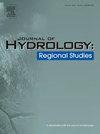Analysis of the spatiotemporal evolution pattern of the synergistic relationship among high temperature, drought, and CHTDs in climate transition zones
IF 5
2区 地球科学
Q1 WATER RESOURCES
引用次数: 0
Abstract
Study region
The Yellow River Basin (YRB)
Study focus
Based on the dry and wet characteristics of the basin, various climate zones are delineated. Subsequently, predictions from the coupled four climate models (CanESM5, CNRM-CM6–1, CNRM-ESM2–1, and IPSL-CM6A-LR) and the statistical downscaling model are used to construct standardized precipitation evapotranspiration indices and standardized temperature indices, which reveal the spatiotemporal evolution characteristics of drought and high temperatures in the watershed under different future scenarios (SSP126, SSP245, SSP585). Finally, the spatiotemporal dynamic evolution characteristics of high temperatures, droughts, and CHTDs (compound high temperature and drought events), where high temperature and drought events occur simultaneously, are analyzed.
New hydrological insights for the regions
By analyzing the evolution patterns of drought in historical and future periods, the results indicate that severe drought in arid regions will alleviate during the period of July to August in the future. Compared to historical periods, the arid region will experience extreme drought, and the southeastern part of the semi humid region will experience varying degrees of drought. Further analysis of the evolution of high temperature events indicates that by 2060, the timing of high temperature events in the basin is expected to gradually shift to late spring. The high temperature events from May to July will cover most of the central and eastern parts of the basin and continue to develop into heatwave events (defined as three consecutive days of high temperature). The spatial variation pattern of CHTDs is relatively similar in three scenarios. From May to July, the CHTDs is expected to become more severe in all climate regions except for arid region, especially in the southeastern semi-humid region, where the affected areas will significantly expand and affect some irrigation districts. In the SSP126 scenario of the future period, the maximum coverage of CHTDs is the largest (19.06 %), and the occurrence month is similar to history. However, in the SSP245 and SSP585 scenarios, the maximum coverage of CHTDs is also advanced to July, but the coverage rate (SSP245 is 17.82 %, SSP585 is 17.80 %) is smaller compared to the SSP126 scenario. From a temporal perspective, as the scenario worsens, the occurrence of CHTDs gradually increases, but mainly concentrated in the near term (2020–2040), and gradually decreases in the medium to long term, especially in the SSP585 scenario, where the occurrence of CHTDs in the long term (2071–2100) is 0. This study provides important reference value for the spatiotemporal evolution of composite events in climate transition zones under different scenarios.
气候过渡带高温、干旱与chtd协同关系的时空演变格局分析
研究区域黄河流域(YRB)研究重点根据流域干湿特征,划分了不同的气候带。随后,利用CanESM5、CNRM-CM6-1、CNRM-ESM2-1和IPSL-CM6A-LR 4种气候模式的耦合预测结果和统计降尺度模型构建标准化降水蒸散指数和标准化温度指数,揭示了未来不同情景(SSP126、SSP245、SSP585)下流域干旱和高温的时空演变特征。最后,分析了高温、干旱和高温与干旱同时发生的复合高温干旱事件的时空动态演变特征。通过对历史和未来时期干旱演变规律的分析,结果表明未来7 - 8月干旱区严重干旱将有所缓解。与历史时期相比,干旱地区将经历极端干旱,半湿润地区东南部将经历不同程度的干旱。进一步的高温事件演化分析表明,到2060年,盆地高温事件发生的时间将逐渐向晚春偏移。5 - 7月的高温事件将覆盖盆地中东部大部分地区,并继续发展为热浪事件(定义为连续三天高温)。3种情景下chtd的空间变化格局较为相似。5 - 7月,除干旱区外,各气候区旱情加重,特别是东南半湿润区旱情加重,影响范围明显扩大,部分灌区受影响。未来一段时间SSP126情景中,chtd的最大覆盖范围最大(19.06 %),发生月份与历史相似。而在SSP245和SSP585场景中,chtd的最大覆盖也提前到了7月,但覆盖率(SSP245为17.82 %,SSP585为17.80 %)要小于SSP126场景。从时间上看,随着情景的恶化,chtd的发生率逐渐增加,但主要集中在近期(2020-2040年),中长期逐渐减少,特别是在SSP585情景中,长期(2071-2100年)chtd的发生率为0。该研究对不同情景下气候过渡带复合事件的时空演变具有重要的参考价值。
本文章由计算机程序翻译,如有差异,请以英文原文为准。
求助全文
约1分钟内获得全文
求助全文
来源期刊

Journal of Hydrology-Regional Studies
Earth and Planetary Sciences-Earth and Planetary Sciences (miscellaneous)
CiteScore
6.70
自引率
8.50%
发文量
284
审稿时长
60 days
期刊介绍:
Journal of Hydrology: Regional Studies publishes original research papers enhancing the science of hydrology and aiming at region-specific problems, past and future conditions, analysis, review and solutions. The journal particularly welcomes research papers that deliver new insights into region-specific hydrological processes and responses to changing conditions, as well as contributions that incorporate interdisciplinarity and translational science.
 求助内容:
求助内容: 应助结果提醒方式:
应助结果提醒方式:


